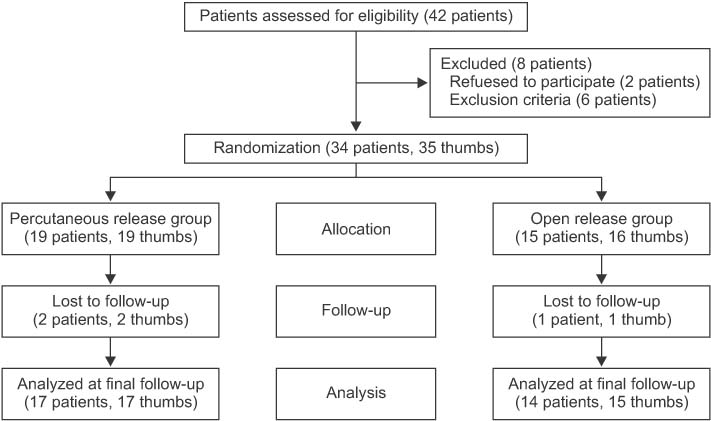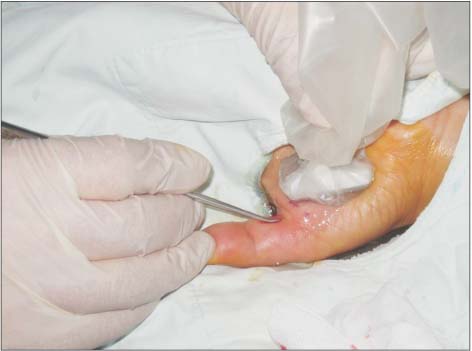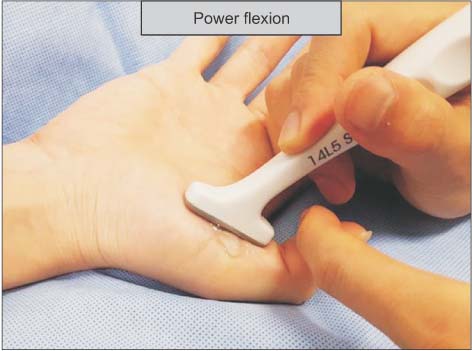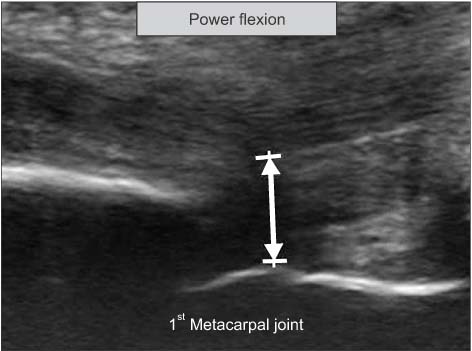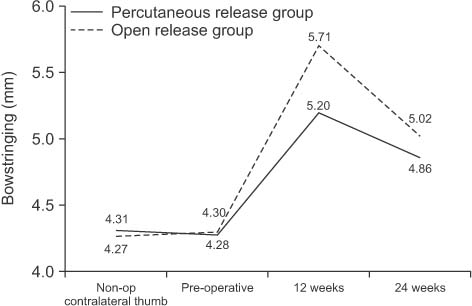Arch Hand Microsurg.
2018 Mar;23(1):20-27. 10.12790/ahm.2018.23.1.20.
A Prospective Study of Bowstringing after A1 Pulley Release of Trigger Thumb: Percutaneous versus Open Technique
- Affiliations
-
- 1Department of Orthopaedic Surgery, Dankook University College of Medicine, Cheonan, Korea. kimjp@dankook.ac.kr
- 2Department of Kinesiology and Medical Science, Graduate School, Dankook University, Cheonan, Korea.
- KMID: 2412487
- DOI: http://doi.org/10.12790/ahm.2018.23.1.20
Abstract
- PURPOSE
In the treatment of trigger thumb, inadequate or excessive release of the flexor pulley can lead to secondary complications such as bowstringing. However, few studies detailed bowstringing after surgical release of the A1 pulley for trigger thumb and its influence on hand function.The purpose of this study was to determine the extent to which the release of the A1 pulley causes bowstringing in the treatment of trigger thumb, and how the percutaneous technique is beneficial to bowstringing and clinical function over open technique.
METHODS
The author prospectively reviewed 31 patients with resistant trigger thumb who were randomized to undergo either percutaneous release (17 patients) or open release (14 patients) of the A1 pulley. We quantified bowstringing of the thumb using ultrasonography at 12 and 24 weeks after surgery. Clinical outcomes were analyzed to correlate with the ultrasonographic measurements.
RESULTS
Each cohort showed a significant improvement in all clinical outcomes (p < 0.05), with no difference between the groups at each follow-up (p>0.05). The bowstringing was greater increased at 12 weeks after surgery in both groups compared to before surgery (5.71±1.04 mm vs. 5.20±0.79 mm, p=0.039). However, the difference of those values was not significant at 24 weeks' follow-up (5.02±0.71 mm vs. 4.86±0.33 mm, p=0.671) There was no significant correlation between the bowstringing and any clinical outcome measures (p>0.271).
CONCLUSIONS
Open A1 pulley release caused greater bowstringing than percutaneous technique at initial after surgery. However, bowstringing did not affect clinical hand function in patients treated with either percutaneous or open technique.
MeSH Terms
Figure
Reference
-
1. Calleja H, Tanchuling A, Alagar D, Tapia C, Macalalad A. Anatomic outcome of percutaneous release among patients with trigger finger. J Hand Surg Am. 2010; 35:1671–1674.
Article2. Guler F, Kose O, Ercan EC, Turan A, Canbora K. Open versus percutaneous release for the treatment of trigger thumb. Orthopedics. 2013; 36:e1290–e1294.
Article3. Sato ES, Gomes Dos, Belloti JC, Albertoni WM, Faloppa F. Treatment of trigger finger: randomized clinical trial comparing the methods of corticosteroid injection, percutaneous release and open surgery. Rheumatology (Oxford). 2012; 51:93–99.
Article4. Wang J, Zhao JG, Liang CC. Percutaneous release, open surgery, or corticosteroid injection, which is the best treatment method for trigger digits? Clin Orthop Relat Res. 2013; 471:1879–1886.
Article5. Bayat A, Shaaban H, Giakas G, Lees VC. The pulley system of the thumb: anatomic and biomechanical study. J Hand Surg Am. 2002; 27:628–635.
Article6. Lin GT, Amadio PC, An KN, Cooney WP. Functional anatomy of the human digital flexor pulley system. J Hand Surg Am. 1989; 14:949–956.
Article7. Heithoff SJ, Millender LH, Helman J. Bowstringing as a complication of trigger finger release. J Hand Surg Am. 1988; 13:567–570.
Article8. Parellada JA, Balkissoon AR, Hayes CW, Conway WF. Bowstring injury of the flexor tendon pulley system: MR imaging. AJR Am J Roentgenol. 1996; 167:347–349.
Article9. Quinnell RC. Conservative management of trigger finger. Practitioner. 1980; 224:187–190.10. Cecen GS, Gulabi D, Saglam F, Tanju NU, Bekler HI. Corticosteroid injection for trigger finger: blinded or ultrasound-guided injection? Arch Orthop Trauma Surg. 2015; 135:125–131.
Article11. Ha KI, Park MJ, Ha CW. Percutaneous release of trigger digits. J Bone Joint Surg Br. 2001; 83:75–77.
Article12. Park KH, Shin WJ, Lee DH, Kim JP. Ultrasound-guided percutaneous release of the trigger thumb. J Korean Soc Surg Hand. 2016; 21:218–224.
Article13. Jou IM, Chern TC. Sonographically assisted percutaneous release of the a1 pulley: a new surgical technique for treating trigger digit. J Hand Surg Br. 2006; 31:191–199.
Article14. Peterson WW, Manske PR, Bollinger BA, Lesker PA, McCarthy JA. Effect of pulley excision on flexor tendon biomechanics. J Orthop Res. 1986; 4:96–101.
Article15. Kuo LC, Su FC, Tung WL, Lai KY, Jou IM. Kinematical and functional improvements of trigger digits after sonographically assisted percutaneous release of the A1 pulley. J Orthop Res. 2009; 27:891–896.
Article16. Leeflang S, Coert JH. The role of proximal pulleys in preventing tendon bowstringing: pulley rupture and tendon bowstringing. J Plast Reconstr Aesthet Surg. 2014; 67:822–827.
Article17. Hudak PL, Amadio PC, Bombardier C. Development of an upper extremity outcome measure: the DASH (disabilities of the arm, shoulder and hand) [corrected]. The Upper Extremity Collaborative Group (UECG). Am J Ind Med. 1996; 29:602–608.18. Crosby CA, Wehbé MA, Mawr B. Hand strength: normative values. J Hand Surg Am. 1994; 19:665–670.
Article19. Gilberts EC, Beekman WH, Stevens HJ, Wereldsma JC. Prospective randomized trial of open versus percutaneous surgery for trigger digits. J Hand Surg Am. 2001; 26:497–500.
Article20. Will R, Lubahn J. Complications of open trigger finger release. J Hand Surg Am. 2010; 35:594–596.
Article21. Low CK, Pereira BP, Ng RT, Low YP, Wong HP. The effect of the extent of A1 pulley release on the force required to flex the digits. A cadaver study on the thumb, middle and ring fingers. J Hand Surg Br. 1998; 23:46–49.22. Manske PR, Lesker PA. Palmar aponeurosis pulley. J Hand Surg Am. 1983; 8:259–263.
Article23. Lin GT, Cooney WP, Amadio PC, An KN. Mechanical properties of human pulleys. J Hand Surg Br. 1990; 15:429–434.
Article24. Mitsionis G, Bastidas JA, Grewal R, Pfaeffle HJ, Fischer KJ, Tomaino MM. Feasibility of partial A2 and A4 pulley excision: effect on finger flexor tendon biomechanics. J Hand Surg Am. 1999; 24:310–314.
Article25. Dierks U, Hoffmann R, Meek MF. Open versus percutaneous release of the A1-pulley for stenosing tendovaginitis: a prospective randomized trial. Tech Hand Up Extrem Surg. 2008; 12:183–187.26. Tavares WC Jr, de Castro UB, Paulino E Jr, et al. Healing of the Achilles tendon in rabbits--evaluation by magnetic resonance imaging and histopathology. J Orthop Surg Res. 2014; 9:132.
Article27. Fowler JR, Baratz ME. Percutaneous trigger finger release. J Hand Surg Am. 2013; 38:2005–2008.
Article28. Cebesoy O, Kose KC, Baltaci ET, Isik M. Percutaneous release of the trigger thumb: is it safe, cheap and effective? Int Orthop. 2007; 31:345–349.
Article
- Full Text Links
- Actions
-
Cited
- CITED
-
- Close
- Share
- Similar articles
-
- Additional Pulley in the Two Cases of Trigger Thumb
- [Erratum] A Prospective Study of Bowstringing after A1 Pulley Release of Trigger Thumb: Percutaneous versus Open Technique
- Complex Regional Pain Syndrome Following Percutaneous Trigger Thumb Release
- Ultrasound-Guided Percutaneous Release of the Trigger Thumb
- Percutaneous A1 Pulley Release of Locked Trigger Thumb in Children

